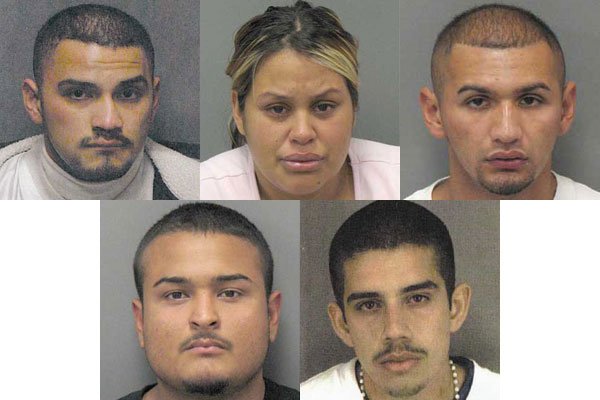A police officer spent two hours Wednesday afternoon detailing
the criminal histories and gang affiliations of three of the four
defendants charged with the 2008 murder of 18-year-old Larry
Martinez.
A police officer spent two hours Wednesday afternoon detailing the criminal histories and gang affiliations of three of the four defendants charged with the 2008 murder of 18-year-old Larry Martinez. After the proceedings, however, family members of the accused pointed out perceived errors in the officer’s testimony and said that many of the incidents he cited occurred when the defendants were juveniles.
When asked if they would like to comment further, most family members chose not to – except for Martinez’s step-father, Mike Fernandez, who railed against the Dispatch outside the courtroom for printing what he said was misinformation about his step-son. He would not give specific examples, however.
Nov. 11, 2008, Martinez was shot and killed by rival gang members in broad daylight near Sixth and Church streets, according to police. Invoking a rarely-used rule – the provocative act murder theory – District Attorney Dolores Carr charged not only the man police believe pulled the trigger – alleged Sureño gang member Cristian Jimenez, 22 – but also two of Martinez’s friends and a female cousin for contributing to his death for the benefit of a criminal street gang.
Robert Barrios, 21, Heather Ashford, 19, and Angel Solorzano, 20, did not intend to kill Martinez, their attorneys said. But even though they didn’t fire the gun that killed their childhood friend and cousin, the three face conspiracy and murder charges for contributing to Martinez’s death during a clash with a rival gang. Martinez, Solorzano and Barrios were Norteño gang members, Gilroy Police Officer Michael Bolton testified.
Jimenez also faces a murder charge and a felony gun possession charge for pulling the trigger of the gun that killed Martinez, according to court documents.
But so far, witness testimony has not supported the claim that Jimenez was one of the shooters, said his defense attorney, Jessica Delgado, on Tuesday.
About half an hour before the shooting, Jimenez and two other Sureños who are still at large – Edgardo Centeno, 20, and an unnamed juvenile – threw a rock at the car Martinez and Solorzano rode in while Ashford drove, according to police. After a brief discussion, Ashford, Martinez and Solorzano picked up Barrios and returned to confront the Sureños, police said. Armed with a small wooden bat, Martinez and his friends snuck up on the Sureños from behind, provoking the rival gang members to turn and shoot, prosecutors said.
After defense attorneys grilled Bolton for half an hour about his credentials, Superior Court Judge Ron Del Pozzo qualified the officer as an expert on Gilroy criminal street gangs. Bolton then spent the better part of Wednesday afternoon describing the gang affiliations of the Larry Martinez, Barrios, Solorzano and Jimenez. Though Bolton mentioned two incidents when police had documented that Ashford was in the company of gang members, he did not believe she was a member of a gang herself, he said.
“For the record, her red shirt was provided by the department of corrections,” Del Pozzo said, breaking the somber mood of the courtroom with the joke and eliciting smiles from Ashford and several members of the audience. Red is a color commonly worn by Norteño gang members, Bolton had testified earlier.
Deputy District Attorney Troy Benson questioned Bolton methodically about the gang affiliations of those involved in the case, beginning with Martinez. Bolton’s testimony followed a week of testimony from witnesses.
Bolton described numerous territorial and gang-related tattoos with which the male defendants and the deceased had branded themselves. Martinez sported a garlic bulb and “408” – his area code – tattooed in red on his arm, Bolton said. Barrios and Martinez both had one dot tattooed on one side of their bodies and four dots on the other, signifying the number 14, a numeral with which Norteños identify, Bolton testified. Solorzano and Barrios both also had their last names tattooed on their backs.
During one run-in with police, Martinez told an officer he had been a Norteño “since the day I was born,” according to Bolton.
But Martinez’s grandmother, Joann Duran, said that even though the teen had a troubled past, he was working to turn his life around. Released from Preston Youth Correctional Facility just days before his death, Martinez planned to attend a job interview the day he was killed, she said.
She said she did not blame Ashford, Barrios and Solorzano for the death of her grandson.
“I am here for Heather and the two boys,” Duran said last month. “They did not kill my grandson.”
Ashford and Martinez were cousins, and Barrios and Solorzano grew up with Martinez, said Duran, who is also Ashford’s godmother. They also carried their friend’s casket during his funeral, Bolton testified.
In trying to establish the gang membership of the three male defendants and Martinez, Bolton listed about two dozen instances when Barrios, Martinez or Solorzano were either arrested or contacted by police for crimes ranging from weapons and drug charges to burglary and assault with a deadly weapon. Many of the instances occurred when the boys were juveniles, as family members pointed out.
As for Jimenez, most of the incidents Bolton referenced were ones in which Jimenez had been a target of Norteño violence.
“Does being a victim of a Norteño gang make you, by default, a Sureño?” Benson asked Bolton.
“Not necessarily,” Bolton answered. But Jimenez’s repeated victimization by Norteño gang members pointed to membership in a Sureño gang, he said.
“I’ve seen no other instances when that individual is not a rival gang member,” Bolton said.
Jimenez also has the word “Sureño” tattooed on his left forearm, Bolton said.
Unlike the other defendants, it did not appear that Jimenez had any family members present at the hearing.
According to statistics maintained by the Gilroy Police Department, Gilroy is home to about 500 Norteños and 150 Sureños.
“When they mix, there are acts of violence against each other as they see each other as enemies,” Bolton testified.
Tensions between the rival gangs ran high prior to Martinez’s death, Bolton said. In late September 2008, a 19-year-old Sureño gang member was shot and killed near Monterey Road and Farrell Avenue in north Gilroy, Bolton said. That murder remains unsolved, he said.
Although attorneys initially estimated the preliminary hearing would last two weeks, the proceedings will extend into next week. They are being held in Department 39 at the Hall of Justice in San Jose.














